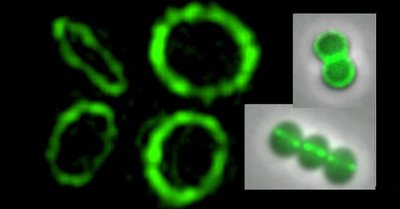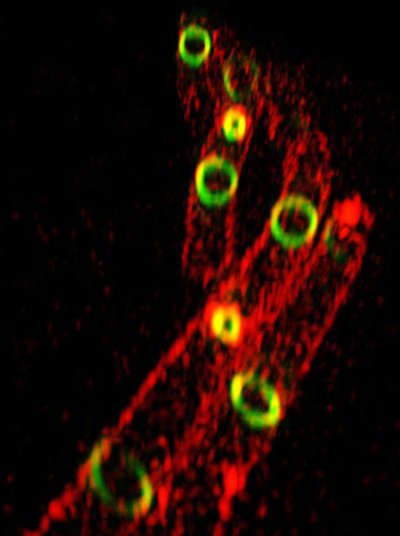Super-resolution microscopy provides insight on cell division
Wednesday, 31 October, 2012
The latest in super-resolution microscope technology has allowed Australian researchers rewrite the book on the process of bacterial cell division, potentially opening the door to new kinds of antibiotics.
Researchers from the ithree institute at the University of Technology, Sydney have outlined a world-first discovery depicting a detailed picture of the structure of the Z-ring, the main protein that controls how a bacterial cell divides, in the latest edition of leading international biology journal PLoS Biology.
Using UTS’s DeltaVision OMX with Blaze SIM Module - the first Blaze microscope in the world to be commercially installed - a team led by Professor Liz Harry has provided the first evidence that the Z-ring actually looks like ‘beads on a string’ in a dividing bacterial cell.

“Previously, researchers believed that the Z-ring was a continuous belt that looped around the cell to make it constrict as the cell split in two during division,” Professor Harry said.
The research revises the model of how cell division occurs inside bacteria and could be the starting point for a new generation of antibiotics targeting the cell division process.
“Bacteria, like all organisms, need to divide in order to survive. The cell doubles in size before dividing in two, ensuring that each newborn cell gets the right number of chromosomes,” Professor Harry said.
“With the original version of the OMX microscope, we could look at the bacteria and get more detail about the Z-ring and its structure, but because the images took a little while to capture, we had to do it on cells that didn’t move - we had to kill them to get them to stay still.
“With the OMX Blaze technology we can speed up the rate of image capture as well as exposing the cells to a much lower amount of energy. This means being able to capture three-dimensional images of live cells without causing damage to them.
“It turns out that the Z-ring is a very dynamic beads-on-a-string structure, changing shape constantly as a cell divides. We also found that other proteins that are involved in the process of cell division follow the same pattern.”

As antibiotic resistance becomes an increasing issue in modern-day health care, new antibiotic targets are essential for finding solutions that will treat infections found in hospitals and the wider community.
“Cell division is a process that has not been targeted by antibiotics to date - and so there is a range of possibilities in how antibiotics could be developed to kill bacteria by inhibiting cell division,” Professor Harry said.

“The use of OMX Blaze has opened up a whole new world of possibilities for biology research, starting with what we have discovered here.”
Paul Goodwin, director of advanced applications at GE Healthcare, the inventor and manufacturer of the Blaze technology, said, “We have worked closely with Professor Harry’s team, and it’s exciting and gratifying to see how quickly they have been able to make truly unique observations that will help progress the vital search for novel antibiotics.”
Director of the ithree institute Professor Ian Charles said, “This groundbreaking research demonstrates how the investment in world-class facilities here in NSW can help us push back our understanding in basic science and at the same time pave a way for application of that science to new medical discoveries.
“We desperately need to find new ways to combat infectious diseases with the rise of resistant superbugs, and I am confident that this research will make a contribution to that urgent quest.”
MRI scanner to advance medical breakthroughs at Monash
Siemens Healthineers' MAGNETOM Cima.X 3T is claimed to be Victoria's most advanced,...
Virtual pathology streamlines rapid onsite evaluation
Technology from Grundium, a specialist in digital imaging for pathology, has been shown to match...
Cannabis detected in breath from edibles
Researchers say they have made the first measurement of THC in breath from edible cannabis, in a...



